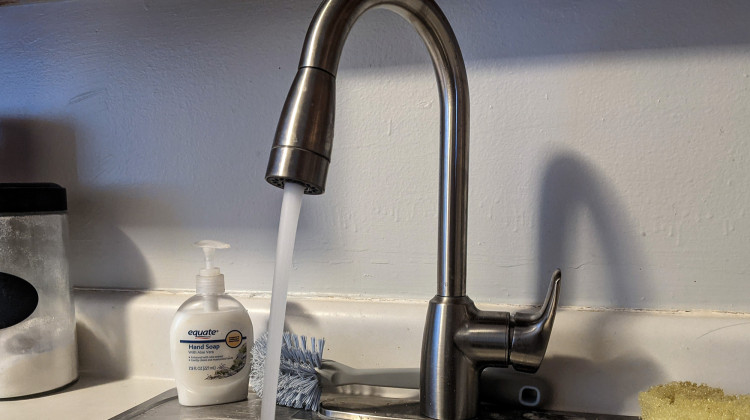
So far, IDEM has found unhealthy levels of PFAS in 19 drinking water utilities — 10 midsize utilities and nine small water utilities.
Lauren Chapman/IPB NewsThe Indiana Department of Environmental Management is testing public drinking water utilities for PFAS.
PFAS are a group of human-made chemicals found in all kinds of non-stick and stain-resistant products — from pans, to carpets to fast-food wrappers.
Among other things, exposure to them has been linked to kidney cancer, problems with the immune system and developmental issues in children.
So far, IDEM has found unhealthy levels of PFAS in 19 drinking water utilities — 10 midsize utilities and nine small water utilities. Some listeners who get their water from these utilities wanted to know how they can protect themselves and their families.
Step 1: Find out if there's PFAS in your water
You can check IDEM's test results on its website. If you live in a big city or have a utility that serves more than 10,000 households, your utility's results might not be available yet. There are also some utilities, like Indiana American Water, that have chosen to do their own testing as well.
There are thousands of individual PFAS chemicals in the environment. It's important to make a note of what specific types of PFAS are in your water if you contact your utility or decide to buy a filter for your home.
Step 2: Ask your utility about its plans to filter out PFAS
The U.S. Environmental Protection Agency has proposed limiting six kinds of PFAS in drinking water — PFOA, PFOS, PFNA, PFHxS, PFBS and HFPO-DA (also known as GenX Chemicals.)
If that rule goes through, water utilities with levels above those limits will have to find a way to filter out the chemicals.
Thomas Speth is a senior science advisor with the Environmental Protection Agency. He recommends finding out what your utility plans to do first and then consider filters for your home.
"If the utility is removing those contaminants, then I think the problem is solved," Speth said.
The EPA has a list of Region 5 contacts for Indiana water utilities interested in grants or loans to help pay for PFAS treatment.
Step 3: Consider buying a filter
The most common type of filter is granular activated carbon — which you can find in your typical home water pitcher filter. Speth said these filters will take out nearly all kinds of PFAS, but are effective for a limited amount of time — which is why they need to be replaced.
Utilities can also use granular activated carbon on a much larger scale. Some, like the city of Bloomington, use powdered activated carbon — granular activated carbon that's been crushed into small particles. The EPA said powdered is not as effective as granular for these big filtration systems.
Then there are ion exchange treatments — which basically use positive ions to attract and remove something with negative ions like PFAS. These are generally more expensive than granular activated carbon. Speth said these are typically more popular for utilities.
Join the conversation and sign up for the Indiana Two-Way. Text "Indiana" to 73224. Your comments and questions in response to our weekly text help us find the answers you need on statewide issues, including this series on climate change and solutions.
There are also high-pressure membrane treatments — so things like reverse osmosis. These are very effective at removing even some harder to treat PFAS, though they use five times as much water as other systems.
Both homeowners and utilities can use high-pressure membranes, but Speth said it's more common to see utilities use them for things like water softening instead of removing pollutants. These systems tend to be more expensive than granular activated carbon or ion exchange.
Of course, there are a lot of filters out there that claim to remove all kinds of contaminants. Speth suggests checking to see if the brand and model are certified by NSF International or the Water Quality Association.
The Environmental Working Group tested 10 different pitcher filters and recommends these four that reduced PFAS by nearly 100 percent: Travel Berkey, Zero Water, Clearly Filtered and Epic Water.
What about bottled water?
Bottled water can also contain PFAS. In a 2021 study, 39 of 100 bottled water brands tested had detectable levels of PFAS — though the EPA hadn't come out with its health guidelines for the chemicals at the time.
The International Bottled Water Association has set its own PFAS limits for its members — but they're still above the EPA's proposed limits for the two most common PFAS chemicals (PFOS and PFOA).
What doesn't remove PFAS?
Many home water softeners and iron filtration systems won't remove PFAS. You also can't get rid of them by boiling your water.
This story has been updated.
Rebecca is our energy and environment reporter. Contact her at rthiele@iu.edu or follow her on Twitter at @beckythiele.
 DONATE
DONATE








 Support WFYI. We can't do it without you.
Support WFYI. We can't do it without you.